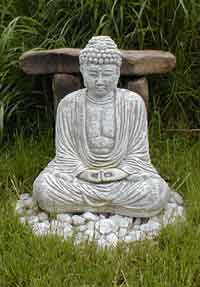
How To Meditate Using MantraMeditatiing with a mantra is a simple and effective way to calm the mind and become centred in the present moment. A mantra is merely a word, sometimes a phrase, that is repeated silently or aloud. The mantra my have special meaning, perhaps a word or phrase that creates a peaceful feeling such as "relax" or "all is well," or possibly one that has spiritual significance, such as “God is love” or "Om." A mantra may also be completely meaningless, a simple sound that is pleasant to the ear and mind such as "ing," "eos," or "umm." Regardless of the mantra selected, the heart of this form of meditation is to use it to distract the mind from it's normal level of chaotic activity. Unless you have chosen a mantra already, explore several. Simply close your eyes and then silently repeat a possible word or phrase several times. Notice your reactions to it. Do you feel pleased or calm? Does it flow smoothly and without effort? Does it resonate for you? Once you get a sense of your reaction to a mantra, try another. Do ths until you find one that feels right. The Setting: As with any form of meditation or contemplation, it is helpful to select a time and place that you can enjoy undisturbed quietude for your practice. Some find a stretching or yoga routine before meditation an excellent aid to mindfulness. Select a comfortable chair that gives adequate back support and helps prevent slouching. Assume a good seated posture, keep your back straight, and drop your chin ever so slightly to straighten the back of the neck. Alternately, you can lie flat on your back with supports under your knees and head. Once you establish a relaxed posture that you think you can maintain for about 20 minutes, you are ready to introduce deep breathing. The Full Breath: This is the fundamental breath
common to most breathing exercises. Now, take several deep breaths in the manner above. This is to relax your body and calm your mind. When you are ready, create a pause of silence in your mind. This pause can feel very much like that moment when you hear someone approach your door and stop at it: there is a pause and gentle anticipation of a knock. Create this mental space and then within it, allow the mantra to emerge in silent expression. After the mantra is expressed, you may notice a moment of calm in it’s wake. This is the point of quietude that is the heart of this form of meditation. You may then notice thoughts beginning to intrude back into your consciousness. When this happens, focus on your breath, re-create the pause, and express the mantra again and so on. With practice, you will notice that the calm following the mantra will become deeper and longer. What is the best thing to do with this moment of silence? Nothing at all: just experience it. You may notice that your attention wanders to physical sensations, your breathing, or things going on around you. If what you are noticing are features of the present moment, this is exactly as it should be. Coming back to the mantra is then a means of continuing in this mindful state. If, on the other hand, you become distracted by thoughts or images in your mind, simply recreate the pause and repeat the mantra again to recenter yourself. At first, as you “think” the mantra, you may notice that your mouth, tongue, and throat make subtle movements as though you were softly uttering the mantra. These “sub-vocalizations” are natural and hard to eliminate at first, but it is better if the mantra is allowed to express itself without these. If you catch yourself making sub-vocalizations, simply pause, relax the face, tongue, and throat and complete the mantra. Similarly, you may find yourself expressing the mantra only while breathing out. If you wish to practice mindfulness meditation as well then by all means continue this. If, however you wish to explore mantra meditation at a deeper level, try releasing the expression of the mantra from this rhythm, allowing it to occur independent of your breathing. It is important to remember that meditation is best approached without expectations. This is something of a paradox because it is perfectly natural for each of us to hold hopes for what it might do for us. The key here is to keep your hopes focussed on the long term and to approach your daily practice with the simple intension of sitting and being for the allotted time. Allow your experience with any given meditation to simply be what it is without weighing it down with desires to reach new depths or even to experience a relaxed state of mind. By releasing your expectations, you open the doorway of potential and free yourself to experience what unfolds. I personally find that simply stating an intention that I sit and drink from the well of meditation helps release me from the demands of the mind.
Copyright ©, 2003 G. S. Renfrey To obtain a copy of this article, click on the link below. It will open a PDF version in a new window which can then be saved. You may need to enable pop-ups from this site for this to happen. |
|


